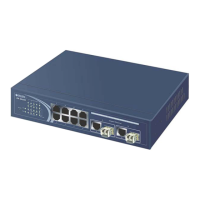ES-2310C User Manual
Publication date: Aug., 2010
Revision A5
63
Parameter description:
IGMP snooping mode selection:
The switch supports three kinds of IGMP Snooping status, including
“Passive”, “Active” and “Disable”.
Disable:
Set “Disable” mode to disable IGMP Snooping function.
Default: Disable
Active:
In Active mode, IGMP snooping switch will periodically issue the
Membership Query message to all hosts attached to it and
gather the Membership report message to update the database
of the Multicast table. By the way, this also reduces the
unnecessary multicast traffic.
Passive:
In Passive Snooping mode, the IGMP snooping will not
periodically poll the hosts in the groups. The switch will send a
Membership Query message to all hosts only when it has
received a Membership Query message from a router.
IP Address:
Show all multicast groups IP addresses that are registered on this device.
VLAN ID:
Show VLAN ID for each multicast group.
Member Port:
Show member ports that join each multicast group. Member port may be
only or more than one.

